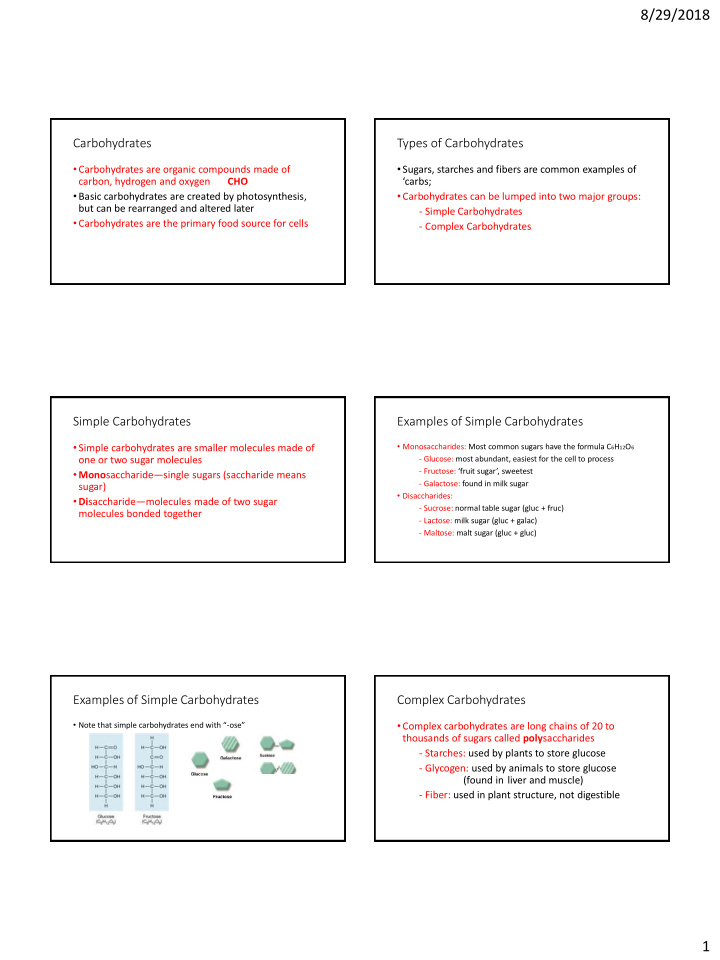



8/29/2018 Carbohydrates Types of Carbohydrates • Carbohydrates are organic compounds made of • Sugars, starches and fibers are common examples of carbon, hydrogen and oxygen CHO ‘carbs; • Basic carbohydrates are created by photosynthesis, • Carbohydrates can be lumped into two major groups: but can be rearranged and altered later - Simple Carbohydrates • Carbohydrates are the primary food source for cells - Complex Carbohydrates Simple Carbohydrates Examples of Simple Carbohydrates • Simple carbohydrates are smaller molecules made of • Monosaccharides: Most common sugars have the formula C 6 H 12 O 6 one or two sugar molecules - Glucose: most abundant, easiest for the cell to process - Fructose: ‘fruit sugar’, sweetest • Mono saccharide — single sugars (saccharide means - Galactose: found in milk sugar sugar) • Disaccharides: • Di saccharide — molecules made of two sugar - Sucrose: normal table sugar (gluc + fruc) molecules bonded together - Lactose: milk sugar (gluc + galac) - Maltose: malt sugar (gluc + gluc) Examples of Simple Carbohydrates Complex Carbohydrates • Note that simple carbohydrates end with “ -ose ” • Complex carbohydrates are long chains of 20 to thousands of sugars called poly saccharides - Starches: used by plants to store glucose - Glycogen: used by animals to store glucose (found in liver and muscle) - Fiber: used in plant structure, not digestible 1
8/29/2018 Examples of Complex Carbohydrates Non-Energy Uses • Plant starches • Carbohydrates aren’t only used for energy • In plants carbs can be used for structure (cellulose...big part of cell wall and wood) • Short glucose chains can signal a cell’s type or provide information to other cells Lipids Types of Lipids • Lipids are hydrocarbon molecules that are insoluble in • Most lipids can be lumped into the following major water, like fats, oils and waxes groups: • Lipids are created by concentrating the energy found - Triglyercides: used for energy in other energy containing compounds - Phospholipids: used in cell membranes • Lipids are primarily for storing energy for use later - Sterols: used for body messaging Triglycerides Phospholipids • Made of a glycerol (simple sugar) with 3 fatty acids • Phospholipids are the main linked to it component of cell membranes • Fatty acids are hydrocarbon chains • They are like triglycerides except one fatty acid tail is replaced with a - Saturated: more hydrogen, solid at room phosphate group (PO 4 ) temperature, ‘animal fat’ - Unsaturated: less hydrogen, liquid at room temperature, ‘plant oil’ 2
8/29/2018 Sterols • Sterols are primarily used for body signaling such as hormones Organic Compounds Part II - Steroids: not just about muscles - Cholesterol: helps build cell membrane and is a Proteins and Nucleic Acids starting point for making other sterols Proteins Protein Jobs • Proteins are organic compounds made of carbon, • Structure: proteins can build cell parts or even body parts (like fingernails) hydrogen, oxygen and nitrogen (CHON) • Action: Cell movement is based on proteins. Organisms move • You might think of proteins from a dietary with muscles, which are mostly protein prospective, but they are some of the most important • Chemical Reactions: reactions in the cell are started and compounds in a cell stopped by proteins called enzymes • Proteins can have roles in structure, action, regulating • Everything the cell does is based on what proteins are cell reactions and more working at that time Amino Acids Amino Acid Structure • Amino acids are the building blocks of proteins • Amino = nitrogen group • Acid = carboxylic acid • The order of amino acid in a protein chain • R-Group = determine which amino acid it is determine the protein’s shape and function • You body can make some amino acids, but others, called essential amino acids, must come from you diet 3
8/29/2018 Protein Structure • Primary Structure: order of amino acids • Secondary Structure: folding of the chain into zig-zags and coils • Tertiary Structure: additional folding of the zig-zags and coils • Quaternary Structure: chains linking to make the completed protein Nucleic Acids Nucleotide Structure • Nucleic acids are organic compounds made of carbon, Phosphate — backbone hydrogen, oxygen, nitrogen and phosphorous of strand (CHONP) Sugar — Ribose (RNA) • Nucleic acids have more defined and specific roles or Deoxyribose (DNA than the other macromolecules Base —gives the ‘letter’ • Nucleic acids: primary carry genetic information for of the nucleotide; the making proteins code part Nucleotide Chains Types of Nucleic Acids • DNA and RNA chains are formed by linking • DNA: instructions for how to make the proteins nucleotides into long threads. • RNA: helps DNA make proteins • DNA is doubled stranded the two strands ‘match up’ • Small nucleic acids: one or two modified with each other nucleotides used fro energy and delivery or signaling (ex. ATP, GTP) 4
8/29/2018 Comparing DNA and RNA Nucleic Acid DNA RNA Sugar Deoxyribose Ribose Structure Double strand Single strand Bases A, T, C, G A, U, C, G 5
Recommend
More recommend